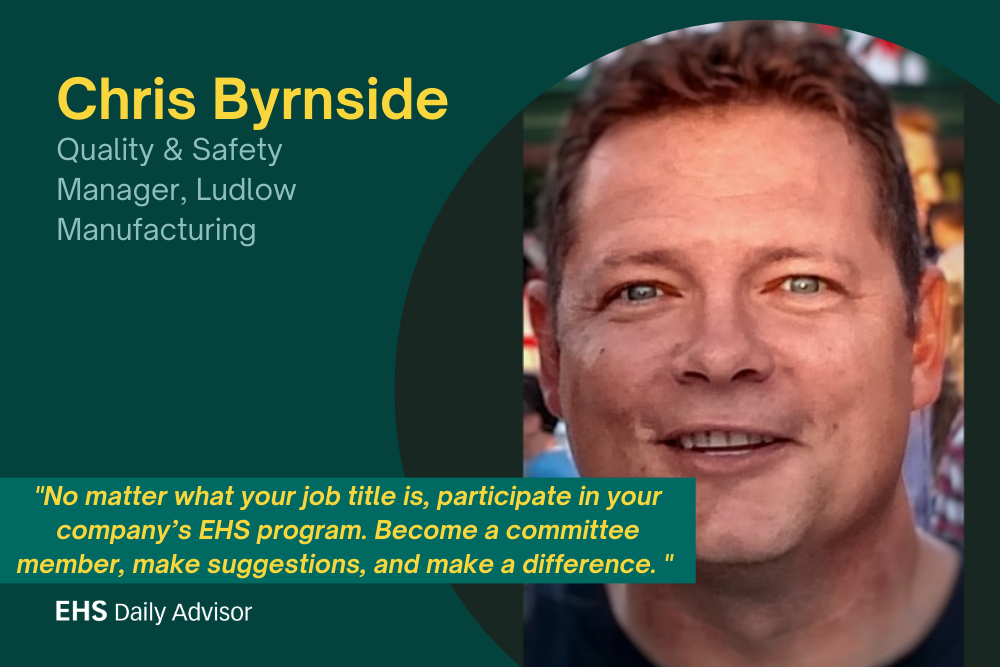Chris Byrnside is a veteran of Desert Storm who began his safety career after he was discharged from the U.S. Army in 1991. He worked in the metals industry in Illinois for his entire 30-year career, beginning as a machine operator at Krueger Steel & Wire in 1992. From 1993 to 2011, he held the positions of crew chief, quality tech, and warehouse manager at Material Sciences Corp, and in 2012 he shifted to quality supervising, then managing at two different organizations.
Since 2019, Chris has served as the Quality & Safety Manager at Ludlow Manufacturing, a family-owned sheet metal fabrication company. At Ludlow, processes include state of the art technology in laser, punch, and sawcutting, manual and robotic forming, manual and robotic welding, machining, and assembly.
For our latest Faces of EHS profile, we sat down with Chris to discuss lessons learned in his career, the advantages of new EHS technologies, and using safety as a key performance indicator.
Q: How did you get your start in the field?
While working for Material Sciences Corp. (MSC), I served as the local president of the United Steel Workers Union. One of my responsibilities was to co-chair MSC’s EHS Committee. For the better part of my 30-year career, I have been involved with the creation and implementation of various EHS programs.
Q: Who has been your biggest influence in the industry?
I am lucky enough to have worked with a gentleman named Lou Krock. Lou spent 50-plus years in the metal industry. Through his knowledge and work ethic, Lou reinforced that there are “right” ways to approach issues, but that every “right” solution is formulated with safety at the forefront.
Q: What’s your best mistake and what did you learn from it?
Early in my career, I focused too much on trying to make improvements to existing policies and procedures. I learned that to make meaningful changes to workplace culture, more times than not, you must start from scratch. I learned that it is much more beneficial to gather current ideas from current employees and establish policies that lead to best practice methodology.
Q: What’s your favorite and least favorite part about working in the industry? Would you change anything?
My favorite part of the industry is the teamwork that goes into completing projects and receiving positive feedback from coworkers. It is discouraging to see the decline in young people entering the trades. Not only is this leading to scarcity of skilled labor, but it is also impacting EHS input and improvements from workforces.
Q: What are your thoughts on safety culture? How can company leaders make safety a value within their organization?
I believe companies should include safety as a key performance indicator. Safety should have a goal and should be quantified, measured, and tracked, by whatever means a company dictates. This can be accomplished by measuring and tracking the number of safety improvements, reductions in accidents, incidents, near-misses, and lost time due to workplace accidents and illnesses, etc. By doing this, a company shows employees, partners, and customers that a safety culture is at the core of their values.
Q: What safety concerns or issues do you think need more prioritization in EHS programs?
Prioritization by leadership. Unless you work at a large company, safety roles within a workplace are normally an added function to employees’ primary jobs, rather than positions dedicated solely to EHS. Some companies value EHS only in slogans. Companies that truly value EHS allot time and resources to their EHS program and participants.
Q: What will be the impact of Environmental, Social, and Governance (ESG) principles on the EHS industry?
Accountability. I see this being no different than the requirements of ISO and other certification organizations. I think employers will find that if they already have structured EHS programs, and if they are invested in EHS values, they are already meeting ESG principles.
Q: How will new safety technologies influence the work being done by EHS professionals?
The progress in EHS open-air solutions via artificial intelligence (AI) and the internet of things (IoT), should be a major influence. The ability to get trends, suggestions, and risks, and disseminate that information in real-time, is what every EHS program strives for. I think that in the very near future, this technology will be the next major advancement in workplace safety.
Q: What are you most proud of?
Being able to make a positive impact on the overall well-being of coworkers.
Q: Do you have any advice for people entering the profession?
No matter what your job title is, participate in your company’s EHS program. Become a committee member, make suggestions, and make a difference.


